
Magento 2 Cache Management: 11 Cache Types for Your Ecommerce
Are you wondering how to boost your store’s speed and improve performance? Magento 2 Cache Management stores frequently used data in different cache types. Users can enable, disable, or check their cache status by managing the full-page cache.
This article will cover the different types of cache used for ecommerce stores.
Key Takeaways
-
What are the aspects of Magento 2 cache management that help your store run faster?
-
Importance of using Magento cache for ecommerce stores.
-
Different types of cache in Magento 2 ecommerce.
-
List of third-party extensions to manage common cache types easier.
-
Troubleshooting issues while using the cache management system in Magento.
-
Caching Considerations for Cache Management in Magento 2.
-
Importance of Magento 2 Cache Management for Ecommerce Store
-
List of Top 10 Magento Cache Management Third-Party Extensions
What is Magento 2 Cache Management?
Magento 2 Cache Management speeds up store by saving frequently used data. It reduces the need to load everything from the database each time, making page load times faster.
Magento 2 Cache Management helps improve store speed by managing cached data. Magento 2 has different caches, including:
-
Page Cache: Stores full pages for quicker loading.
-
Image Cache: Saves product images for fast display.
-
Layout Cache: Caches page layouts for reuse.
Users can control the cache through the cache management page or the command line. It lets you enable or disable the cache, flush caches, or clear specific cache types after updates. Users can follow commands to:
-
Clean cache types using
php bin/magento cache:clean. -
Check cache status using
bin/magento cache:status. -
Flush caches with
bin/magento cache:flushto clear old data.
Importance of Magento 2 Cache Management for Ecommerce Store
1. Improved Website Performance
Magento 2 Cache Management keeps your store running fast and smooth. It stores the data that customers use often. By using different cache types, it cuts down the time needed to load pages. It is beneficial during busy times when your site gets more visitors. Caching reduces the load on the server, helping pages load faster.
-
Faster Page Load Times: Magento uses cache to store things. It includes things like page layouts, images, and other data, so it does not need to reload them each time. Magento cache makes pages load faster, giving customers quick access to the products.
-
Reduced Server Load: Caching reduces how often the server needs to access the database. It lowers the load on the server, allowing it to handle more visitors without slowing down. During busy times, it saves the site from crashing and costly server upgrades.
-
Better User Experience: Customers expect a fast, smooth shopping experience. When pages load quickly, they are more likely to stay and explore more products. Cache management helps the site run faster and improves the customer shopping experience.
2. Increased Conversion Rates
The speed of the Magento 2 store can impact how many visitors become customers. Fast pages help customers browse and buy, while slow pages make them leave without buying.
-
Lower Bounce Rates: Slow pages can make visitors leave your site. Cache management speeds up your site, keeping visitors engaged and lowering bounce rates. Fast-loading pages encourage customers to explore more products. They help in increasing the chances of a purchase.
-
Better Customer Satisfaction: A fast store creates a positive experience for customers. Quick, easy browsing makes customers more likely to complete their purchases. Slow sites frustrate customers and lead to Magento abandoned carts. The fast ecommerce websites keep them satisfied.
-
Mobile Optimization: Many customers shop on their phones and expect fast loading times. By clearing the cache, you make sure the site loads fast for mobile users. Slow mobile experiences can make customers leave. A fast site keeps them engaged and helps them shop for products.
3. Better Search Engine Rankings
Search engines like Google rank websites faster. Good cache management helps the site load faster. It improves the website ranking and brings more visitors to the Magento store.
-
Better SEO: Faster websites rank higher in search results. This is because Google and other search engines prioritize fast-loading pages. A well-optimized cache helps the site rank better. It leads to more traffic and potential sales. More traffic means more chances for Magento 2 conversion rates.
-
Improved Crawl Efficiency: A well-cached site is more accessible to search engines. It helps the users to crawl and index. This means the pages will show faster when you make updates or add new content. Cache management clears out old data, so search engines only see fresh content. It improves the visibility of the Magento 2 site.
4. Cost-Effective Scalability
Good cache management helps the Magento store handle more visitors. It needs extra server resources to grow the store without increasing costs.
-
Lower Hosting Costs: Optimized cache settings let your store handle more visitors. It is done without needing more expensive server upgrades or bandwidth. This reduces hosting costs while still allowing merchants to serve more customers. By reducing strain on the server, you can save money and keep the stores running smoothly.
-
Better Traffic Handling: During busy times, such as sales or special promotions. The Magento store may get more visitors than usual. A well-cached site can handle the extra traffic without slowing down or crashing. Flushing a cache type like full page cache ensures a fast and stable site. It takes advantage of busy periods without losing customers due to slowdowns.
11 Cache Types for Ecommerce Stores in Magento 2
1. Configuration Cache

The configuration cache saves all the settings for your store. It helps by not loading these settings from the database every time a page is opened. For example, when you change store settings like currency or tax rules. The cache stores this information, reducing database queries. The cache type improves the Magento 2 store's performance by cutting down the time it takes to load pages.
Tip: Always flush this cache type after making configuration changes.
2. Layout Cache

The layout cache saves the compiled page layout for faster page rendering. It keeps the page structure ready, so the layout does not need to be rebuilt each time a visitor opens a page. For example, when you change the design or theme of your store. The layout cache ensures that these changes load quickly.
Tip: Clean the cache after updating your theme or layout files.
3. Block HTML Output Cache

The block HTML output cache stores blocks the pre-rendered HTML. This means that the site does not need to recreate the blocks each time someone visits. The block HTML cache speeds up loading times. For example, blocks like the header or footer that appear on every page are cached to load faster.
Tip: Clean or flush this cache after making changes to HTML or block elements.
4. Collections Data Cache

The collections data cache stores results from database queries. It reduces the number of times Magento needs to access the database, speeding up page loads. For example, when multiple users view the same product category. The cache ensures that Magento does not query the database repeatedly for the same data.
Tip: Clear the cache after updating or adding products. It ensures the correct data is displayed.
5. DDL Cache

The DDL cache stores database schema information. It reduces the need for repeated schema queries. Data Definition Language (DDL) cache improves tasks related to the database structure. For example, when Magento needs to check the structure of a database table. The information is cached to avoid repeated queries.
Tip: Flush the cache after making changes to the database schema.
6. EAV Cache (Entity Attribute Value)

The EAV cache saves data related to product and customer attributes. It improves the access times for the information. For example, if you add new product attributes. The EAV cache stores this data, so it loads faster when customers view the product pages.
Tip: After changing product or customer attributes. Users should clear the Magento 2 cache to apply the updates.
7. Full Page Cache (FPC)

The Magento full-page cache saves entire pages to load quickly without regenerating. For example, when a customer visits a product page. The full page cache allows the whole page to load instantly if it is already cached, reducing server load. It improves the Magento 2 store performance, especially during heavy traffic.
Tip: Flush this cache type after making content updates or adding new pages.
8. Reflection Cache

The reflection cache stores data about class properties and methods. It makes the tasks that use classes faster by reducing the time needed to access class data. For example, when Magento needs to handle complex operations like product searches. The reflection cache speeds up these processes by storing class information.
Tip: Flush the cache after making changes to class files or methods.
9. Translations Cache

The translations cache stores translations for multi-language stores. It ensures that translated content loads faster for users browsing in different languages. For example, if the store operates in English and French. The translations cache speeds up page loads by storing translated text.
Tip: Flush this cache type after updating translations or language packs.
10. Web Services Configuration Cache

The web services configuration cache stores settings for external services like APIs. It helps speed up communication with third-party services by avoiding repeated configuration queries. For example, if the store integrates with a payment gateway or shipping service. The cache stores the data to reduce the need to reload it.
Tip: Clear the cache after updating any external services or web integrations.
11. Integration Configuration Cache

The integration configuration cache stores settings for systems like CRMs or ERPs. It reduces the time needed to load integration data during each page request. For example, if the store is linked to an ERP system for Magento inventory management. The cache stores the integration settings to speed up data transfers.
Tip: Flush the cache after making changes to integration settings to apply the updates.
List of Top 10 Magento Cache Management Third-Party Extensions
1. Varnish Cache

Varnish Cache is an external caching solution that boosts the Magento 2 full page cache. It stores the entire pages in memory. Varnish cache integrates well with both Magento open source and Adobe Commerce. It reduces the server load and improves page load times during high traffic.
Key Feature: Cleans up the cache automatically. Ensuring pages are served quickly from memory.
2. Redis Cache

Redis Cache stores session data and various Magento 2 cache types in memory. It helps speed up database queries, enhancing the store's overall performance.
Key Feature: Redis improves the commerce cache management system by storing cache entries for faster access.
Pricing:
-
Essential: $5/month
-
Pro: $0.881/hour
3. LiteMage Cache
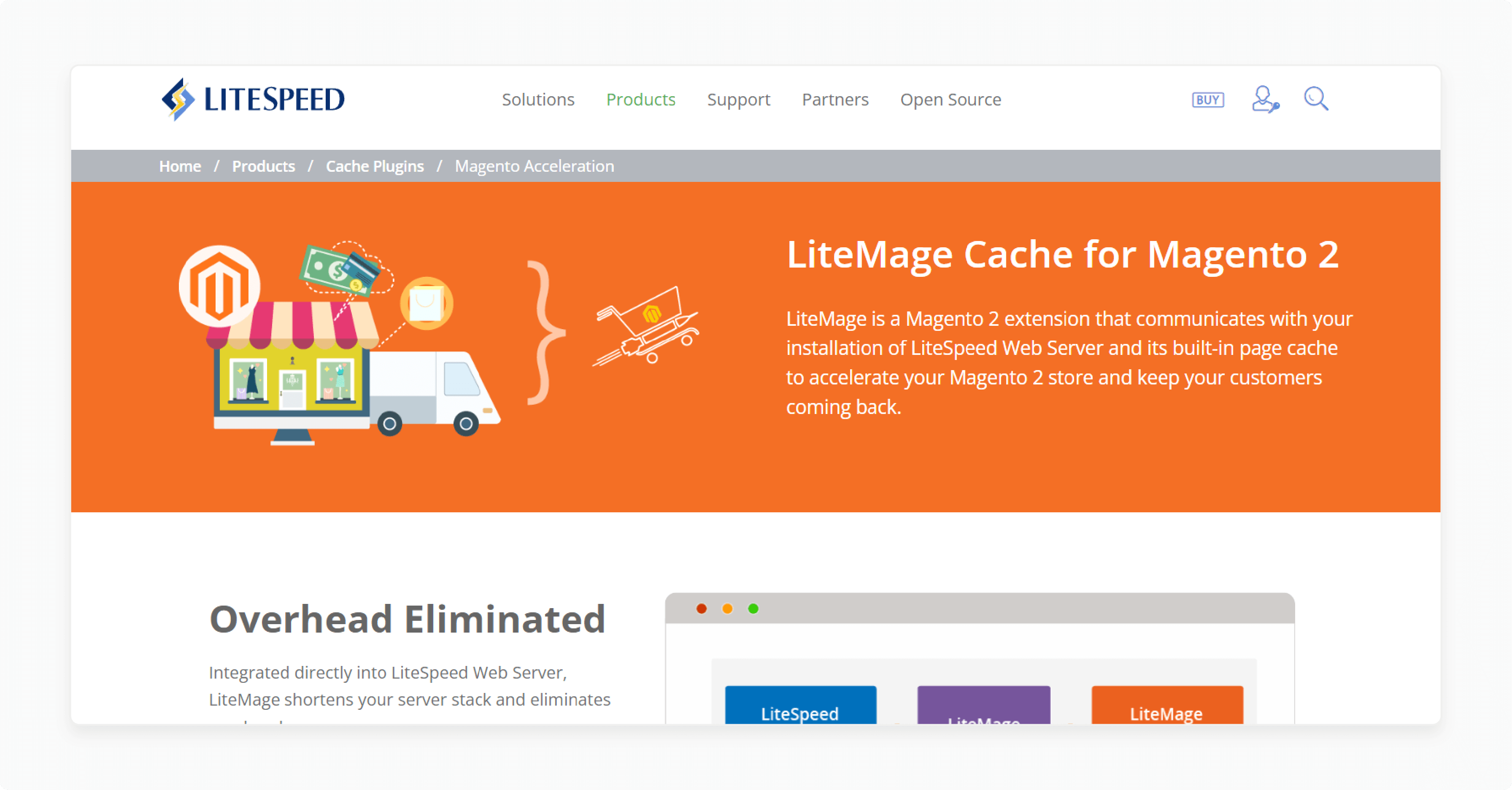
LiteMage Cache works with LiteSpeed servers. It speeds up Magento full page cache management. LiteMage caches both guest and logged-in user sessions. It boosts the speed of web applications like Magento.
Key Feature: Cleans only the cache that is needed. It makes the server more efficient while ensuring fast page loads.
Pricing:
-
Starter:
-
Site owner: $10/month
-
Site owner plus: $16/month
-
-
Standard:
-
Site owner: $50/month
-
Site owner plus: $56/month
-
-
Unlimited:
-
Site owner: $110/month
-
Site owner plus: $116/month
-
4. Full Page Cache Warmer for Magento 1 by Amasty
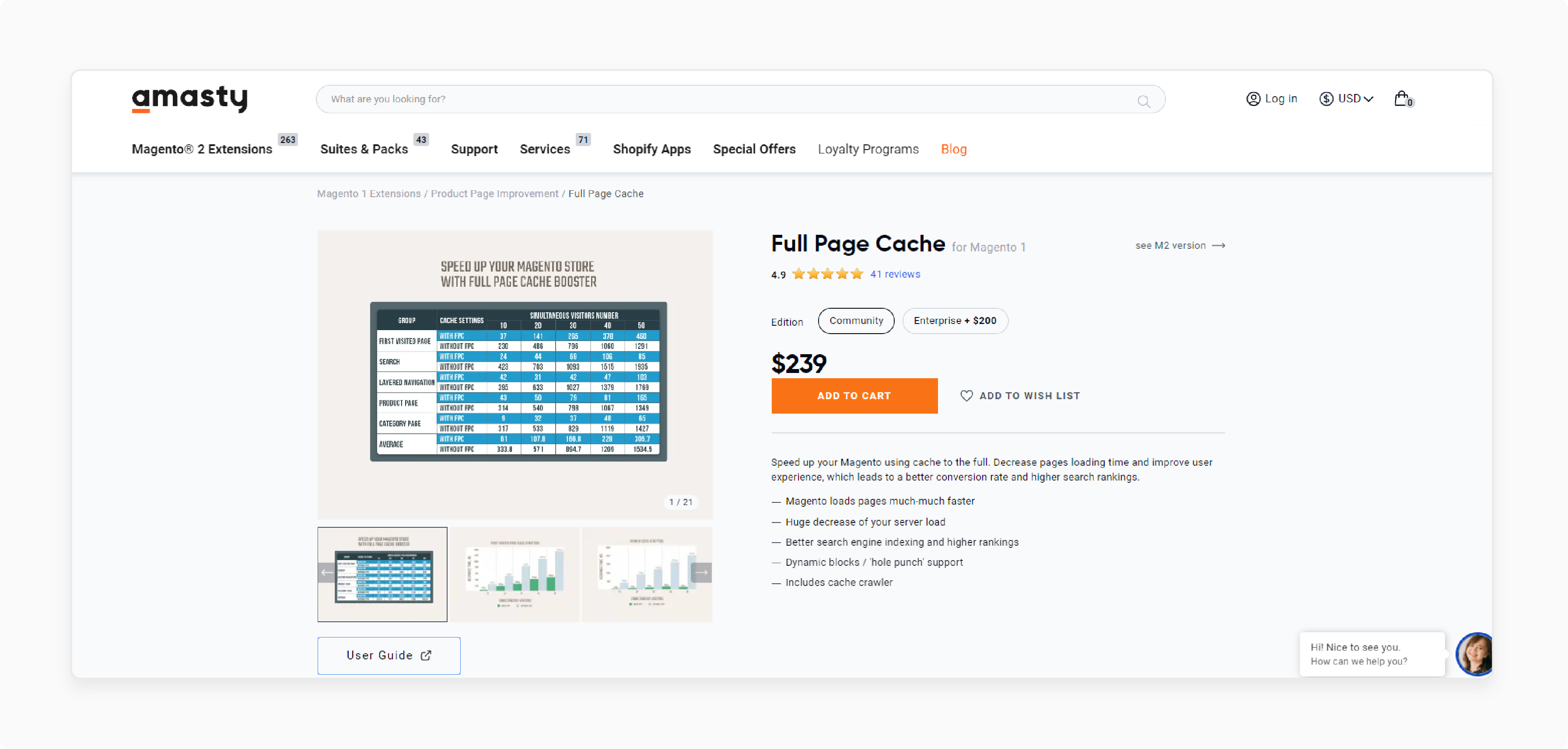
Amasty Full Page Cache Warmer for Magento 1 keeps the page cache updated. It does this by "warming" pages after they are cleared. The extension makes sure pages are ready to load quickly after changes.
Key Feature: Automatically warms pages, keeping the cache types fresh during peak demand.
Pricing:
-
Community Edition: $239
-
Enterprise Edition: $439
5. Full Page Cache for Magento 2 by Mirasvit
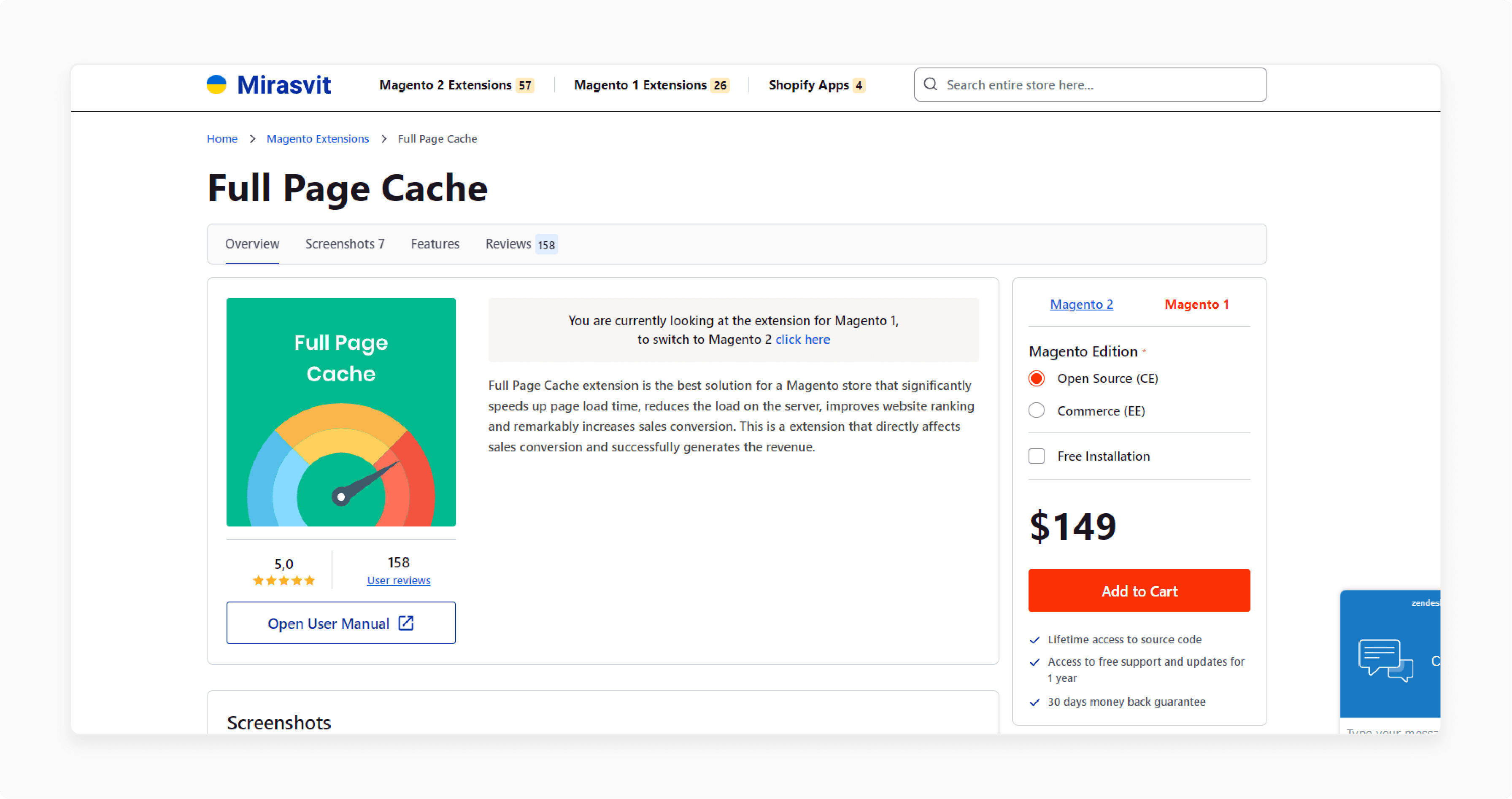
Mirasvit Full Page Cache Warmer preloads important pages into the cache. The extension ensures that pages are ready to load fast. It uses smart rules to decide which pages to warm based on traffic and updates.
Key Feature: Works with cache management tools. It automates clearing cache and re-caching important pages.
Pricing:
-
Open Source (CE): $149
-
Commerce (EE): $248
6. Full Page Cache Warming Adobe
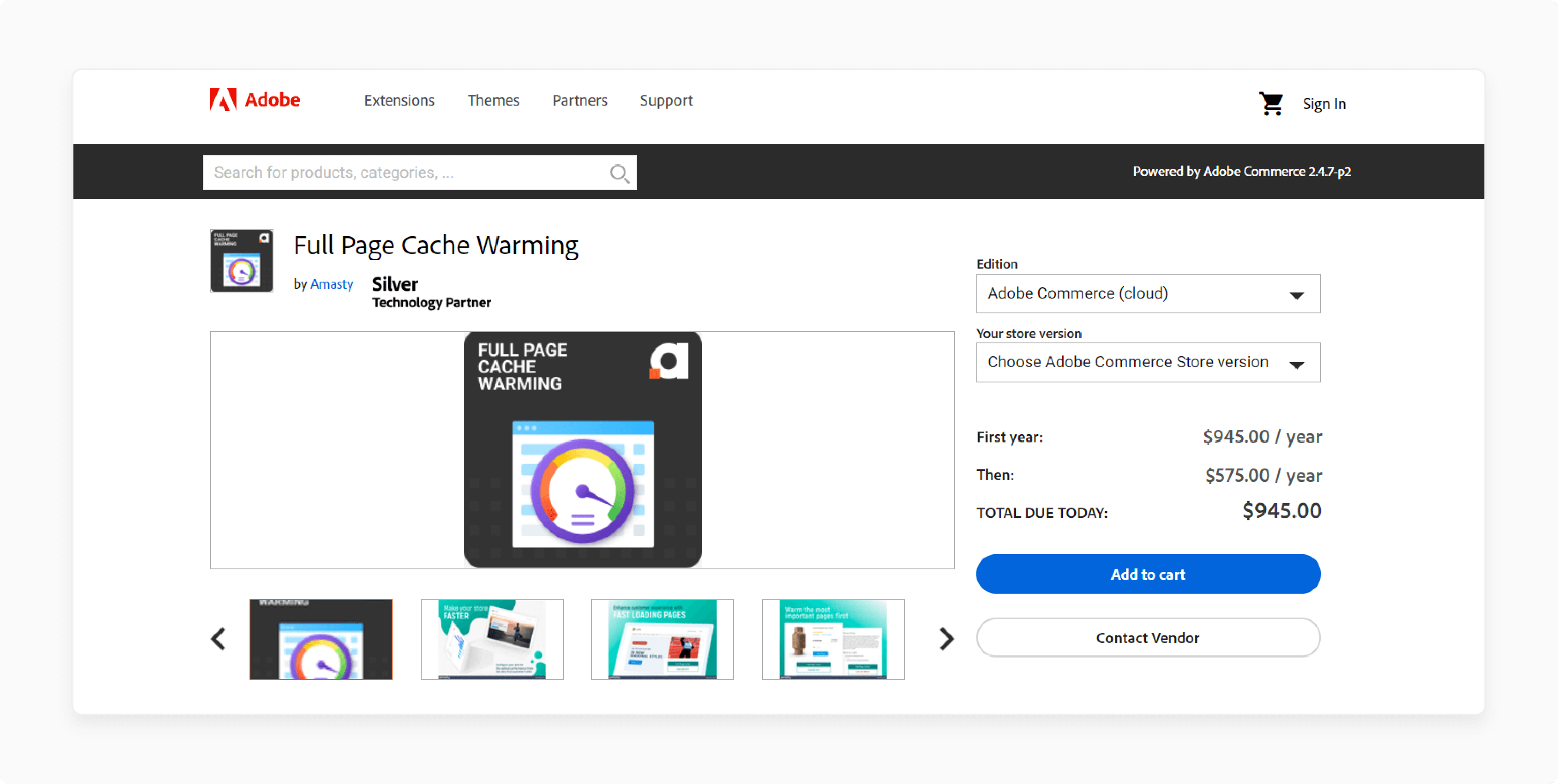
Adobe Full Page Cache Warming tool integrates with Magento open source. The pre-cache important pages load faster for Adobe.
Key Feature: Automatically clears cache types during peak times. Ensures quick page load speeds, even under heavy traffic.
Pricing:
| Version/Edition | Adobe Commerce (cloud) | Adobe Commerce (on-prem) | Magento Open Source |
|---|---|---|---|
| 2.4 (Adobe Commerce (cloud)) | $945 | $599 | $255 |
7. Magento 2 Full Page Cache Warmer (beta) by Magefan
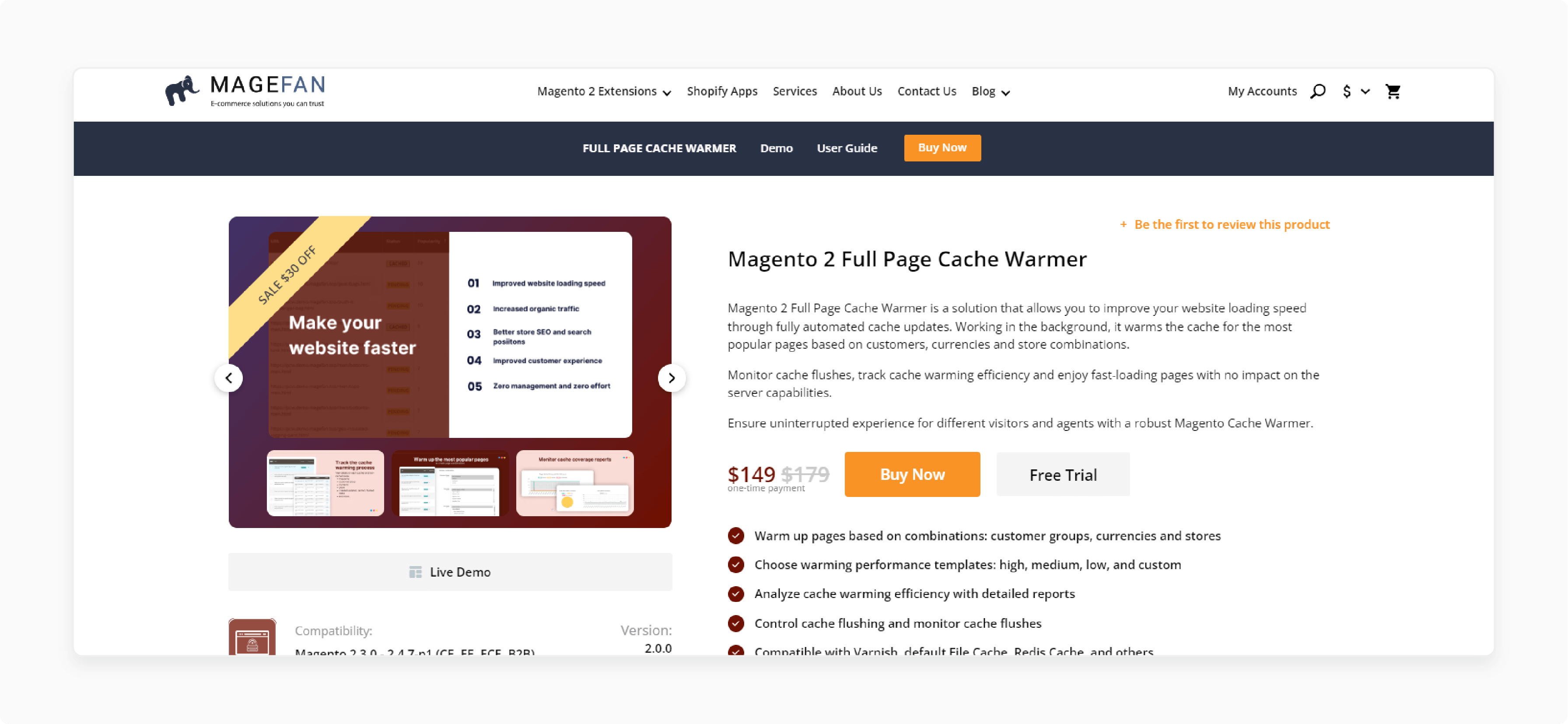
Magefan Full Page Cache Warmer (beta) automatically refreshes the Magento full page cache. It makes sure pages load fast after updates.
Key Feature: Caches pages after updates, keeping them ready for quick access.
Pricing: $149 (one-time payment)
8. Cache Warmer for Magento 2 by ExtendWare
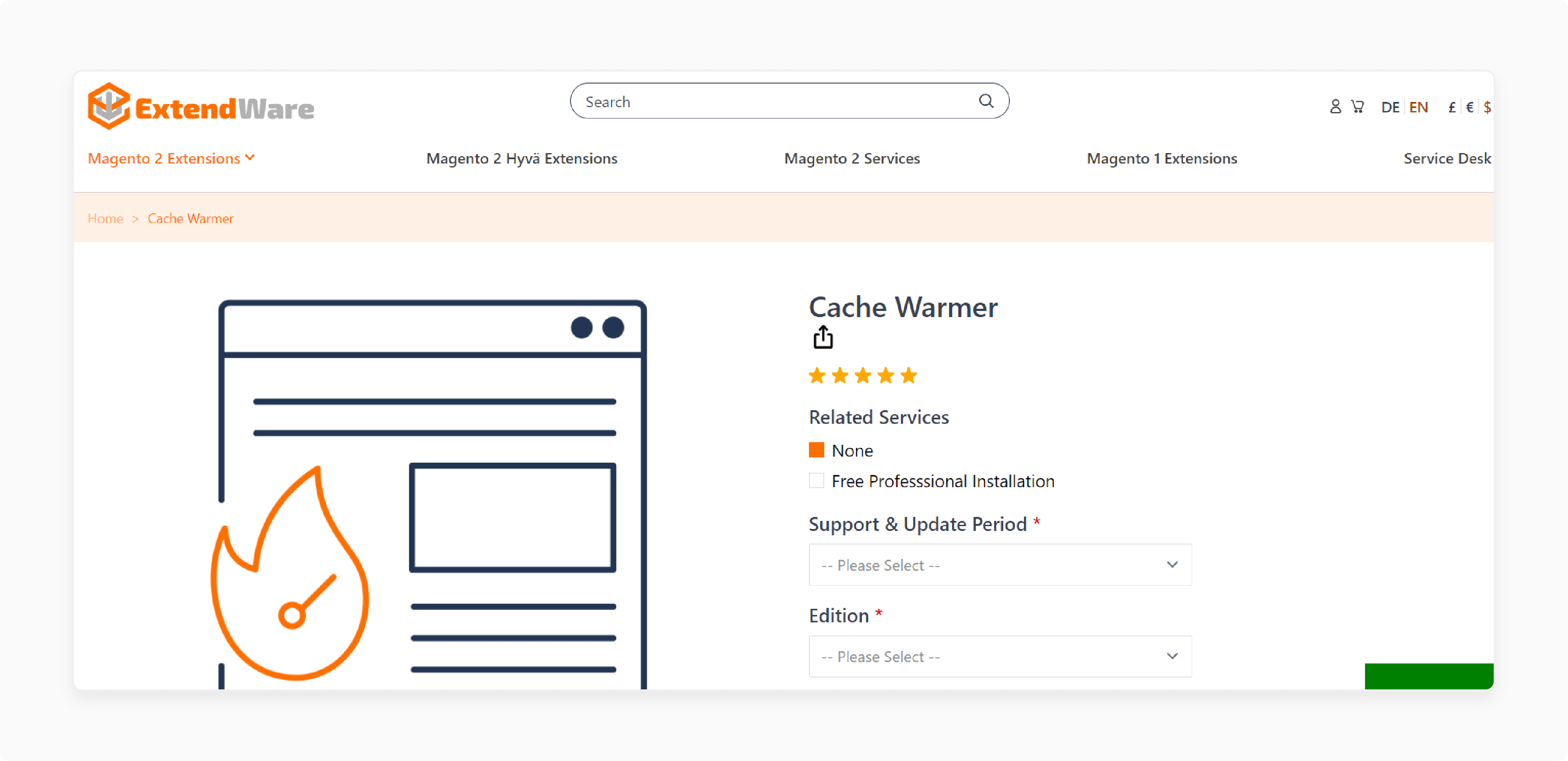
ExtendWare Cache Warmer simulates customer behavior. It keeps frequently visited pages "warmed" in the cache. The extension improves the commerce cache performance by pre-loading popular pages.
Key Feature: Enable or disable cache for specific pages, ensuring key pages load fast.
Pricing:
| Edition/time | 6 Months | 1 Year | 2 Years |
|---|---|---|---|
| Adobe Commerce | $232.70 | $304.30 | $411.70 |
| Magento Open Source | $179 | $250.60 | $358 |
9. Full Page Cache Warmer by Mirasvit
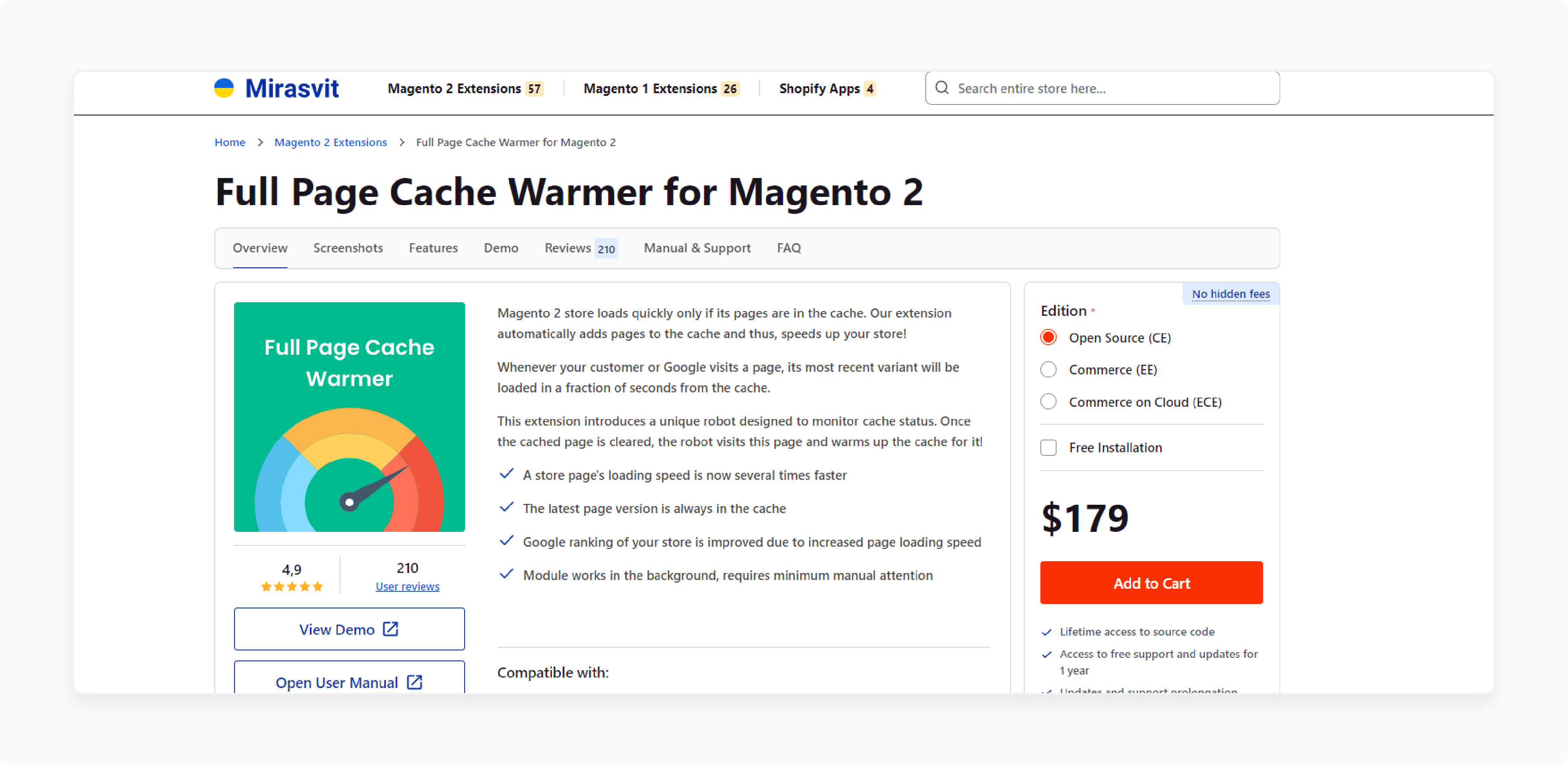
Mirasvit Full Page Cache Warmer is built for Magento 2 cache types. It makes sure key pages are cached and load quickly.
Key Feature: Fully integrates with the command line using the commerce platform. It is easy to cache automation and management.
Pricing:
-
Open Source (CE): $179
-
Commerce (EE): $459
-
Commerce on Cloud (ECE): $719
10. Full Page Cache Warmer for Magento 2 by Amasty

Amasty Full Page Cache Warmer keeps the Magento full page cache updated. It automatically warms pages after they are cleared. It ensures both high-traffic and low-traffic pages load quickly.
Key Feature: Automatically clears the cache storage for invalidated pages. Warms them again for better ecommerce performance.
Pricing:
-
Community Edition: $219
-
Enterprise Edition: $519
-
Magento Cloud Edition: $819
Troubleshooting Common Magento 2 Cache Management Issues
| Issue | Details | Solution |
|---|---|---|
| Cache Not Updating Properly | The cache does not reflect store updates after changes. | Clear Magento 2 cache using the command bin/magento cache:clean. Clears all Magento-enabled cache types and refreshes the store content. |
| Cache Issues During Peak Traffic | The site slows down during high traffic if cache types during peak demand are managed poorly. | Manage the cache proactively. Schedule automatic clearing of commerce cache during off-peak hours to avoid slowdowns. |
| Cache Shows Stale Data | Old content is served due to outdated cache entries. | Check cache status using bin/magento cache:status. Clean and flush cache types if necessary to keep content fresh. |
| Cache Invalidation Problems | The cache does not invalidate, leading to outdated content being displayed to users. | Check enabled cache types and manually clear and flush cache types if necessary. Use cache management tools to review cache status. |
| Full Page Cache Not Working | Magento 2 full page cache is not working. It causes slower page loads, especially during high traffic. | Ensure full page cache is enabled using bin/magento cache:enable full_page. Check the status of each primary cache in the Magento admin panel. |
| Cache Permissions Issues | File permissions on cache directories prevent clearing cache or accessing specific cache entries. | Ensure correct permissions by running: chmod -R 775 var/cache var/page_cache. It fixes permission issues. |
| Cache Conflicts with Extensions | Third-party extensions interfere with the Magento 2 cache. It causes the cache not to clear. | Temporarily disable cache types related to the extension. Use the command: bin/magento cache:disable [cache_type]. Re-enable cache after testing. |
| Cache and CDN Integration Issues | CDN and Magento full page cache may not sync, causing delayed content updates. | Configure your CDN to clear Magento cache automatically when updates are made. Set up scripts for automatic cache clearing. |
| Cache Not Cleared After Updates | Product images or page layouts do not update after changes. | After updates, flush the cache using bin/magento cache:flush. It ensures the latest data is displayed. |
| Disabling Cache for Development | During development, the Magento 2 cache may cause outdated content to be served. | Disable all cache types in development mode using bin/magento cache:disable. Re-enable cache after development is complete. |
Caching Considerations for Cache Management in Magento 2
| Tools | Things to Consider |
|---|---|
| Full Page Cache (Enhanced) | Full page cache improves performance. It does this by caching the page layout from all components. Customize it to manage how Magento 2 full page cache work together for dynamic content. |
| Third-Party Extensions | Choose third-party extensions that work with Adobe Commerce and Magento Open. Tools like cache warmers can pre-generate cache. They ensure smooth clearing of the commerce cache. |
| Varnish Integration | Varnish integrates with the cache that Magento uses to improve Full Page Cache and block caching. Use Varnish ESI to manage the merged result to the cache for dynamic content caching. |
| Magento 1 to Magento 2 Migration | When migrating from Magento 1 to Magento 2, understand the differences in the caches. Adjust the caching strategy for better results in cache entries during the migration. |
| Cache Management (Enhanced) | When migrating, understand the differences in types of Magento 2 cache. You can easily enable or disable all cache types as needed. |
FAQs
1. How do I disable Magento 2 cache?
To disable the Magento 2 cache, go to the admin panel. Find cache management. You can either disable all cache types or just a specific cache. You can also use the command line command bin/magento cache:disable. It will stop the cache from storing outdated data.
2. How can I check the cache status in Magento 2?
Check the cache status in Magento 2 by going to the cache management section in the admin panel. You will see the default cache types supported by Magento and their status. To check using the command line, run bin/magento cache:status.
3. What happens when cleaning a cache type deletes data?
When cleaning a cache type deletes data, it removes cached information. However, it does not erase actual data stored on the Magento server. After clearing the cache, Magento will reload the cache the next time the page is accessed.
4. How do I access all cache management options in Magento 2?
You can access all cache management options in the admin panel. It allows you to manage all cache types supported by Adobe for both Commerce and Magento Open Source. You can also use the command line for faster control.
5. How do I clear the catalog product images cache in Magento 2?
To clear the catalog product images cache, go to cache management in the admin panel or use the command line. It is important to clear the cache after updating product images. Later on, the new images will display correctly.
6. How does Magento 2 automatically clean up cache?
Magento 2 cleans up the cache automatically to keep storage space from filling up. It happens during tasks like product updates or order processing. Magento helps the e-commerce store’s cache logic run smoothly.
Summary
Magento 2 Cache Management helps boost store performance. It stores frequently used data in various cache types. Store owners can manage all cache settings through the admin panel. Consider the following considerations:
-
Full Page Cache: Using Magento, cache the full page layout. Configure full page cache for dynamic content.
-
Third-Party Extensions: Use extensions to enable this cache. They help with clearing the commerce cache.
-
Varnish Integration: Varnish works with cache types in Magento 2 for better caching.
-
Magento 1 to Magento 2 Migration: Consider the type of cache and adjust your caching strategy.
Explore Magento hosting services to manage cache management for your ecommerce store.



